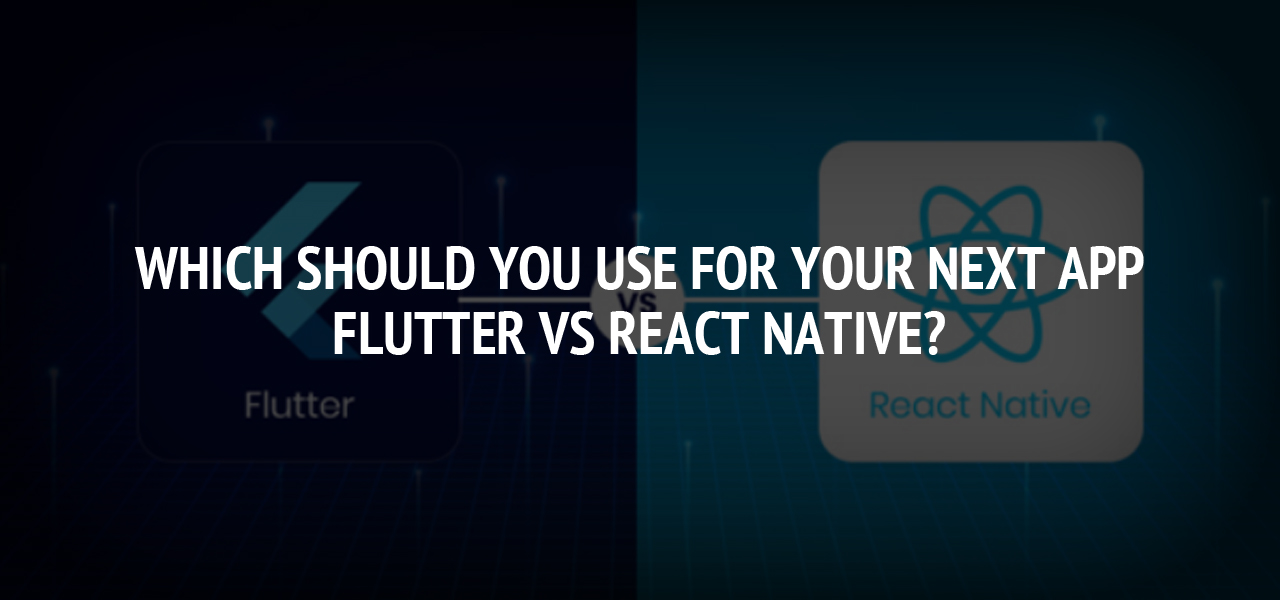Which Should You Use for Your Next App: Flutter Vs React Native?

Selecting the right framework for your application is super important to decide its functionalities and productivity. A poorly-developed application won’t work efficiently on every device and might lead to stuttering, lags, or even malfunction. There’s a constant debate between the two cross-platform development frameworks; Flutter and Reactive Native.
Understanding the Frameworks
Reactive Native and Flutter frameworks are used in cross-platform app development. Both of them provide assistance to the developers to decrease the time to launch a project into the market and thus improve productivity. In this blog, we are going to draw a comparison between Flutter and React Native with their architecture, learning curve, performance, community support, use case, and various other factors.
What is Flutter?
It is an open-source framework that works with the programming language called Dart (Developed by Google). This framework is commonly preferred for its improved UI toolkit used for creating cross-platform applications with a single codebase. The developers are able to develop a flexible and expressive UI with native performance by using flutter app development. The Google team of developers supports and contributes to this framework for effective flutter app development. Plus, developers have the backing of an entire flutter community.
Where Flutter is Used
- It is used for creating MVP mobile applications
- Applications following the material design language
- Applications that have OS-level functionality
- OS plugins that work with simple logic
- Apps compatible with Skia rendering engine
- Reactive applications using huge data integration
- Innovative UI with advanced widgets
What is React Native?
It is another widely popular open-source framework that works on JavaScript. React Native app development has the main aim of native rendering of applications that are compatible with Android and iOS. A unique combination of XML- JavaScript and Esque markup is used to write React Native. This framework was created by Facebook for react native app development and currently, there are over 50 dedicated engineers working on React Native. The framework depends on native components instead of depending on web components as building blocks.
Where React Native is Used
- It is used for developing simple cross-platform applications
- React Native is ideal for fast prototype applications
- It is effective for applications with a simple user interface
- React Native is ideal for applications that almost appear native
- React Native is preferred for applications with reusable components
- It is useful for applications that work with synchronous APS.
Let’s Draw a Comparison Between Flutter and React Native with This Chart
|
|
Flutter |
React Native |
|
Definition |
A UI toolkit for the development of natively-compiled applications for mobile, web, desktop from one codebase |
A framework used in the development of applications with React |
|
Release Date |
December 2018 |
March 2015 |
|
Invented by |
|
|
|
Open-Source |
Yes |
Yes |
|
Used Programming Language |
Dart |
JavaScript |
|
Userbase |
Over 120,000 users on GitHub (May 2021) |
Over 95,300 users on GitHub (May 2021) |
|
Tops Apps Created with the Technology |
Google Ads App, My BMW, Xianyu app by Alibaba, Hamiton, Philips Hue |
Facebook, Instagram, Skype, Tesla, etc. |
|
The UI Differences |
|
|
|
Competitive Advantages |
|
|
|
Not Ideal When |
|
|
Which One to Choose for Mobile Application Development?
Both of the frameworks are reliable for creating reliable applications. However, there are different use cases where you should choose one of the two options.
Native Platform Support
Flutter can be used for not only mobile and web applications; we can use flutter app development for desktop and embedded applications as well. It is much better when your application can be accessed through almost any device including phone, tablet, laptop, desktop, etc.
Performance
Flutter apps work with native code, thus improving the overall performance. However, these apps might face performance issues if the graphics functionalities are not optimized from time to time.
Ease of use
The traditional JavaScript developers consider that is much easier to learn React Native. Whereas, learning Flutter requires expertise in Dart programming language
Size of Project
React Native projects are comparatively more lightweight than Flutter projects. It could be a great option for developing applications for wearable devices with limited storage. Thus, choosing react native app development makes a more sensible option.
About The Author
Related Blog
View All-
5 Omnichannel Strategies for Boosting App Productivity
Omnichannel strategies are cohesive approaches to customer engagement across multiple platforms and touchpoints. It’s derived from the Latin word omnis, meaning “all” or “every.” Instead of operating in silos, these strategies aim ...
-
The Importance of Fintech App Development in the 21st Century
Financial technology applications are one of the resources that most individuals will come across daily. Fintech apps are used in businesses, startups, households, schools, and in most industries across the globe. In the 21st century we place most of our trust ...







